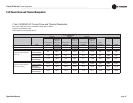
Operation Manual
I-Tech HD Series Power Amplifi ers
page 52
In System Architect, you create audio connections between sending
devices (transmitters) and receiving devices (receivers). For example,
a mixer could be a transmitter, and a power amp could be a receiver.
You assign each connection a Bundle number. The Bundle number
indi cates which devices are communicating with each other.
Also in System Architect, you address each connection as Multi-
cast or Unicast. A Multicast (Broadcast) connection is from one
trans mitter to multiple receivers. A Unicast connection is from one
transmitter to one receiver. For example, if you send a mixer’s digital
audio signal to sev eral power amps, the signal would be Multicast.
Unicast is most used on “switched” networks requiring more than 64
channels.
You specify a connection as Multicast or Unicast by the delivery
address it you give it in System Architect. 255 and lower is Multicast
(Broadcast); 256 and up is Unicast.
The “Receiver Count” monitor indicates how many devices are
receiving the digital audio bundle. The “Active” indicator indicates
whether the par ticular Bundle is being actively transmitted onto the
network.
9.2.4 The Conductor
A CobraNet system is coordinated by one audio device in the network
called the Conductor. It regulates the CobraNet digital audio traffi c
on the CobraNet network. That is, the Conductor is the master clock
for the rest of the network.
You choose one device to be the network conductor based on a
priority scheme. The Conductor indicator will light on the CobraNet
device that is serving as the conductor.
The Conductor handles time-division multiplexing and clock recovery
on the network. The Conductor periodically broadcasts a well-defi ned
“beat” packet to all components to recover synchronous timing
information. The “beat” also specifi es which addresses can transmit
at certain time slots within the “beat” period.
Each transmitting device is allowed to transmit in a given time-slot
within the Conductor-controlled isochronous cycle time. The time-
slot is deter mined by the assigned bundle priority. Higher bundle
priorities receive lower-numbered positions and are transmitted fi rst.
9.2.5 Switched Networks
A more complex CobraNet network can be built using Ethernet
switches. Switches do not simply broadcast each and every packet
to all nodes. Instead, they check each incoming data packet to
determine its destination and (very quickly) transmit the data to only
that destination port. This allows for more network data fl ow, more
Bundles and more audio channels.
In effect, each network port in an audio component has 100MB of
band width. The network can be as large as 100MB times the number
of ports on the network.
Another advantage of switched networks is “full-duplex” connections
between components. A full-duplex link allows simultaneous send
and receive over the same Ethernet connection.


















